
Coatings
Scope & Guideline
Transforming Ideas into Coating Solutions.
Introduction
Aims and Scopes
- Materials Science of Coatings:
Investigates the composition, structure, and properties of various coating materials, including metals, ceramics, polymers, and composites. - Coating Applications:
Explores diverse applications of coatings in industries such as automotive, aerospace, biomedical, and electronics, focusing on their functional performance. - Advanced Coating Techniques:
Covers innovative methods for coating fabrication, including physical vapor deposition (PVD), chemical vapor deposition (CVD), electrochemical deposition, and laser-based techniques. - Corrosion and Wear Resistance:
Studies the efficacy of coatings in providing protection against corrosion, wear, and other forms of degradation in harsh environments. - Self-Healing and Smart Coatings:
Researches the development of coatings that can autonomously repair damage or respond to environmental stimuli, enhancing their longevity and functionality. - Environmental and Biocompatible Coatings:
Focuses on the formulation and application of eco-friendly and biocompatible coatings for sustainable practices in various sectors. - Characterization and Testing Methods:
Emphasizes the importance of advanced characterization techniques to evaluate coating properties, performance, and durability.
Trending and Emerging
- Nanostructured Coatings:
There is an increasing focus on the development of nanostructured coatings, which offer enhanced mechanical, thermal, and electrical properties due to their unique surface characteristics. - Sustainable and Biodegradable Coatings:
Research into eco-friendly and biodegradable coatings is gaining momentum, driven by environmental concerns and regulatory pressures to reduce plastic waste. - Smart and Self-Healing Coatings:
There is a growing interest in smart coatings capable of self-repairing or responding to external stimuli (such as temperature or moisture), which enhances their functionality and lifespan. - Advanced Characterization Techniques:
Emerging trends include the use of advanced characterization methods, such as in-situ techniques and machine learning algorithms, to better understand coating behavior and properties. - 3D Printing and Additive Manufacturing for Coatings:
The integration of 3D printing technologies in coating applications is on the rise, enabling tailored coatings with complex geometries and functionalities. - Bioinspired Coatings:
Research into coatings inspired by natural systems is on the rise, focusing on properties like self-cleaning, anti-fogging, and antibacterial effects.
Declining or Waning
- Traditional Coating Materials:
There has been a noticeable decrease in research focused on conventional coatings, such as basic epoxy and polyurethane systems, as newer materials and technologies gain attention. - Single-Function Coatings:
The trend is shifting away from coatings designed for single functions (e.g., solely anti-corrosion) toward multifunctional coatings that combine properties like self-cleaning, anti-fouling, and thermal resistance. - Laboratory-Scale Studies:
Research that is solely focused on laboratory-scale experiments without practical applications or scalability considerations is becoming less common, as there is a push for studies that bridge the gap between laboratory findings and industrial applications. - Passive Coatings:
Interest in passive coatings that do not respond to environmental changes is diminishing in favor of active or responsive coatings that offer enhanced performance.
Similar Journals

Obrabotka Metallov-Metal Working and Material Science
Fostering Collaboration in Engineering ExcellenceObrabotka Metallov-Metal Working and Material Science is a pivotal journal published by Novosibirsk State Technical University, focusing on the dynamic fields of mechanical engineering, mechanics of materials, and the science of metals and alloys. With ISSN 1994-6309 and E-ISSN 2541-819X, the journal serves as a crucial platform for disseminating research from Russia and around the globe. Currently classified in the Q4 category for Mechanical Engineering and Mechanics of Materials, as well as Q3 for Metals and Alloys, it encompasses a wide range of studies from fundamental research to innovative applications. Despite its relatively recent inception in 2019, the journal has established itself with Scopus rankings that highlight its growing influence—Rank #122 out of 176 in Materials Science and Rank #510 out of 672 in Engineering. This journal aims to foster collaboration among researchers, professionals, and students by featuring original articles, reviews, and technical notes that address contemporary challenges in metal processing and material science. As it continues to evolve through 2024, Obrabotka Metallov remains dedicated to enhancing the understanding and application of materials science, making it a significant resource for those invested in the future of engineering and technology.

Journal of Coatings Technology and Research
Exploring the Science Behind Coatings ExcellenceThe Journal of Coatings Technology and Research, published by Springer, stands as a vital resource for researchers and professionals in the fields of materials science and chemistry. With an ISSN of 1547-0091 and an E-ISSN of 1935-3804, this journal is recognized for its significant contributions to the study of coatings technology, encompassing diverse aspects from surfaces and interfaces to colloids and surface chemistry. Currently holding a 2023 Impact Factor that places it in the Q2 and Q3 quartiles across several categories—including Chemistry and Colloid and Surface Chemistry—the journal serves as an essential platform for disseminating innovative research. Its accessibility options cater to a broad audience, ensuring that both established scholars and emerging researchers can engage with the latest findings. Since its inception in 2004, the journal has continued to foster advancements in coatings technologies, promoting sustainable practices and novel applications across industries.
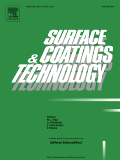
SURFACE & COATINGS TECHNOLOGY
Advancing the Frontiers of Surface EngineeringSURFACE & COATINGS TECHNOLOGY is a premier academic journal that has been at the forefront of research and innovation since its inception in 1986, diligently published by Elsevier Science SA. With an impressive range of studies focusing on surface and coatings technologies, the journal has established itself as a leading platform within the fields of Chemistry, Condensed Matter Physics, and Materials Science. Notably, it holds a distinguished Q1 ranking in multiple categories, showcasing its relevance and high impact in the academic community. Furthermore, it is recognized for its rigorous peer-review process and is indexed in esteemed databases, maintaining its strong position with a ranking of #17 in Surfaces, Coatings, and Films. Although the journal does not currently offer open access options, it continues to be a crucial resource for researchers, professionals, and students seeking insights into cutting-edge developments and applications in the domain of surface engineering. With a commitment to advancing knowledge across these disciplines, SURFACE & COATINGS TECHNOLOGY is an essential read for anyone interested in the latest trends and technologies shaping the industry.

Corrosion Science and Technology-Korea
Innovating solutions to combat corrosion challenges.Corrosion Science and Technology-Korea, published by the CORROSION SCIENCE SOC KOREA, is a pivotal journal dedicated to the exploration and advancement of knowledge in corrosion science, particularly within the context of materials performance and maintenance. Established to foster innovation and collaboration among scholars in South Korea and beyond, this journal focuses on areas such as electrochemistry, metal alloys, and surface coatings, catering to a diverse audience of researchers, professionals, and students in materials science and chemistry. Despite its current quartile rankings, including Q4 in Electrochemistry and Q3 in various materials-related categories, the journal aims to enhance its visibility and impact in the scientific community by publishing high-quality research and reviews. With its ISSN 1598-6462 and E-ISSN 2288-6524, Corrosion Science and Technology-Korea is committed to contributing to the understanding and mitigation of corrosion issues, thereby promoting sustainability and longevity in engineering applications.
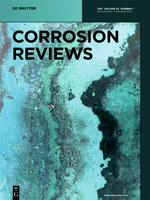
CORROSION REVIEWS
Empowering Professionals with Cutting-Edge Corrosion KnowledgeCORROSION REVIEWS, published by WALTER DE GRUYTER GMBH in Germany, is a pivotal journal dedicated to advancing the understanding and management of corrosion phenomena across various fields including Chemical Engineering, Chemistry, and Materials Science. With an ISSN of 0334-6005 and an E-ISSN of 2191-0316, this esteemed journal has demonstrated an enduring commitment to scholarly excellence since its inception in 1979, encompassing comprehensive interdisciplinary research outputs and reviews. Ranked in the Q2 category across several disciplines for 2023, and positioned favorably in Scopus rankings—#94 in Chemical Engineering and #145 in Chemistry—it serves as an essential resource for researchers and professionals seeking to enhance their knowledge and application of corrosion science. While the journal does not currently offer open access, its rigorous peer-review process ensures high-quality, credible research publications that contribute significantly to the academic community's efforts in corrosion prevention and policy. Researchers, students, and industry professionals alike will find CORROSION REVIEWS an indispensable tool for staying at the forefront of this critical area of study.
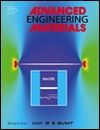
ADVANCED ENGINEERING MATERIALS
Elevating Research in Condensed Matter PhysicsADVANCED ENGINEERING MATERIALS is a leading journal dedicated to the field of materials science, particularly within the realm of condensed matter physics. Published by WILEY-V C H VERLAG GMBH in Germany, this esteemed journal has been a crucial platform for disseminating cutting-edge research since its inception in 1999. With an impressive impact factor and ranked in the top quartiles of its categories, it boasts a Q1 ranking in Condensed Matter Physics and a Q2 rank in related materials science fields as of 2023. ADVANCED ENGINEERING MATERIALS serves a diverse readership, including researchers, industry professionals, and students, striving to advance the understanding and application of innovative materials. Frequent contributions to this journal help bridge theoretical advancements with practical applications, fostering a vibrant academic and industrial dialogue. Although currently not an open-access journal, the insights shared within its pages are pivotal for anyone engaged in the dynamic sectors of engineering and material sciences.
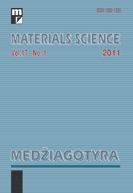
Materials Science-Medziagotyra
Fostering Collaboration in the World of Materials ScienceMaterials Science-Medziagotyra is a prominent peer-reviewed journal dedicated to the field of materials science, published by Kaunas University of Technology in Lithuania. Since its transition to an Open Access model in 2012, it has facilitated broad dissemination of research findings, enhancing accessibility for researchers and professionals worldwide. This journal is indexed in Scopus and has consistently contributed to the academic community with a focus on innovative materials and their applications, ranking in the Q3 category of Materials Science (miscellaneous) as of 2023. With the responsibility of synthesizing substantial research from 2008 through 2024, Materials Science-Medziagotyra aims to bridge gaps in material research while fostering collaboration among scientists, students, and industry leaders. Its commitment to quality and rigor in scientific discourse underscores its relevance and importance in advancing the field.

SURFACE COATINGS INTERNATIONAL
Unveiling Cutting-Edge Developments in Surface CoatingsSURFACE COATINGS INTERNATIONAL is a prominent journal dedicated to the field of surface coatings, providing a critical platform for researchers, professionals, and students involved in this ever-evolving discipline. Published by the Oil & Colour Chemists Association, this journal disseminates high-quality, peer-reviewed articles that explore innovative advancements, applications, and methodologies related to coating technologies. With a focus on both theoretical and practical aspects, the journal aims to bridge the gap between research and real-world applications, promoting excellence in the development and performance of surface coatings across various industries. Although it does not currently operate on an open access model, the significance of its contributions to the field, coupled with its commitment to fostering scientific discussion, positions SURFACE COATINGS INTERNATIONAL as an essential resource for those seeking to enhance their knowledge and innovate within this specialized area.
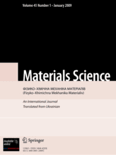
MATERIALS SCIENCE
Unveiling the Science Behind Tomorrow's Materials.MATERIALS SCIENCE, a prominent journal published by SPRINGER, serves as a vital resource for researchers, professionals, and students in the fields of materials science, mechanical engineering, and condensed matter physics. With its ISSN 1068-820X and E-ISSN 1573-885X, this journal has been dedicated to sharing innovative research since its inception in 1993, and it continues to publish groundbreaking findings through 2024. Although it operates as a traditional subscription-based journal, its ranking in the Q3 quartile across multiple scientific categories, including Condensed Matter Physics, Materials Science, Mechanical Engineering, and Mechanics of Materials, signifies its relevance and impact in the academic community. Notably, its Scopus classifications reveal a competitive standing among its peers, ranking within the 25th to 33rd percentiles across various engineering and physics disciplines. The journal remains a key platform for disseminating valuable insights, fostering collaboration, and advancing the understanding of materials science.
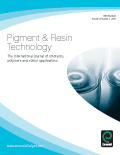
Pigment & Resin Technology
Unveiling Breakthroughs in Pigment and Resin ApplicationsPigment & Resin Technology is an esteemed journal published by Emerald Group Publishing Ltd, focusing on the interdisciplinary fields of materials chemistry and coatings science. With a history spanning from 1972 to 2024, the journal serves as a vital platform for disseminating innovative research and developments concerning pigments, resins, and related materials technologies. Holding a respectable position in the Q3 category for both Materials Chemistry and Surfaces, Coatings, and Films as of 2023, it ranks within the 40th percentile among its peers, underscoring its relevance and impact within these domains. Although it does not currently offer open access, the journal remains a key resource for researchers, professionals, and students aiming to stay abreast of cutting-edge findings and practical applications in materials science. As such, Pigment & Resin Technology is essential reading for those engaged in the innovation and application of advanced materials in various industries.